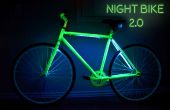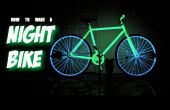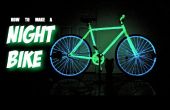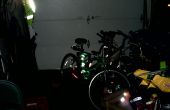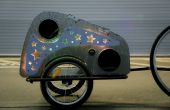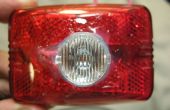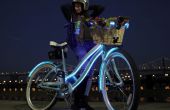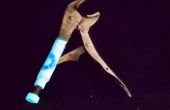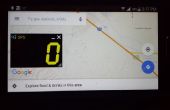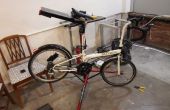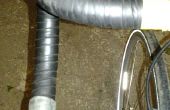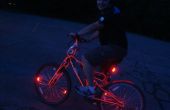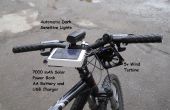Stap 4: Aan de slag met de FastLED bibliotheek en uploaden van de schets van de Arduino

Ik werk vooral met de FastLED.io bibliotheek voor het programmeren van de LED, het is vrij moeiteloos als het gaat om RGB-programmering, en ze geweldige documentatie voor hun code hebben.
Hier is een instructable detaillering van de installatie van de bibliotheek FastLED.
Dit is de Code die nodig hebt om te uploaden naar de Arduino:
// // // // // // // ultimate night bike by AUDREY LOVE // a project for Arduino, Radioshack LED Tricolor Light Strip, and a bicycle. // // // // // with great support from the FastLED.io Library // download it here: https://github.com/FastLED // // // #include "FastLED.h" #define NUM_LEDS 10 #define DATA_PIN 6 CRGB leds[NUM_LEDS]; //__________pin designations int programIndicator = 13; //Pin Number for the LED program indicator int buttonPin = 2; // the number of the pushbutton pin // Variables will change: int ledState = LOW; // ledState used to set the LED long previousMillis = 0; // will store last time LED was updated long intervalOne = 1500; // interval at which to blink (milliseconds) long intervalTwo = 500; // interval at which to blink (milliseconds) long intervalThree = 300; // interval at which to blink (milliseconds) long intervalFour = 200; // interval at which to blink (milliseconds) long intervalFive = 100; // interval at which to blink (milliseconds) long intervalSix = 50; // interval at which to blink (milliseconds) int brightValue = 0; int satValue = 0; int hueValue = 0; //button boolean buttonValue = true; // variable for reading the button status boolean buttonState = true; // variable to hold the button state //pattern int patternProgram = 0; // which button program is in use void setup() { // declare signal pins pinMode(programIndicator, OUTPUT); pinMode(buttonPin,INPUT_PULLUP); // sanity check delay - allows reprogramming if accidently blowing power w/leds delay(2000); FastLED.addLeds<TM1803, DATA_PIN, GBR>(leds, NUM_LEDS); Serial.begin(9600); // initialize serial communication at 9600 bits per second: } void loop() { // Serial.println(buttonValue); Serial.println(patternProgram); // button presses cycle through modes buttonValue = !digitalRead(buttonPin); // read input value and store it in val if (buttonValue != buttonState) { // the button state has changed! if (buttonValue == 0) { // check if the button is pressed if (patternProgram == 0) { // if set to smooth logarithmic mapping patternProgram = 1; // switch to stepped chromatic mapping } else { if (patternProgram == 1) { // patternProgram = 2; // switch to next mode } else { if (patternProgram == 2) { // patternProgram = 3; // switch to next mode } else { if (patternProgram == 3) { // patternProgram = 4; //switch to next mode } else { if (patternProgram == 4) { // patternProgram = 5; //switch to next mode } else { if (patternProgram == 5) { // patternProgram = 0; // switch to next mode } } } } } } } buttonState = buttonValue; // save the new state in our variable } brightValue = analogRead(A2); satValue = analogRead(A3); hueValue = analogRead(A4); Serial.println(hueValue); switch(patternProgram){ case 0: leds[0] = CHSV((hueValue/4)+1, (satValue/4)+1, (brightValue/4)+1); leds[1] = CHSV((hueValue/4)+1, (satValue/4)+1, (brightValue/4)+1); leds[2] = CHSV((hueValue/4)+1, (satValue/4)+1, (brightValue/4)+1); leds[3] = CHSV((hueValue/4)+1, (satValue/4)+1, (brightValue/4)+1); leds[4] = CHSV((hueValue/4)+1, (satValue/4)+1, (brightValue/4)+1); leds[5] = CHSV((hueValue/4)+1, (satValue/4)+1, (brightValue/4)+1); leds[6] = CHSV((hueValue/4)+1, (satValue/4)+1, (brightValue/4)+1); leds[7] = CHSV((hueValue/4)+1, (satValue/4)+1, (brightValue/4)+1); leds[8] = CHSV((hueValue/4)+1, (satValue/4)+1, (brightValue/4)+1); leds[9] = CHSV((hueValue/4)+1, (satValue/4)+1, (brightValue/4)+1); FastLED.show(); // delay(40); break; case 1: { unsigned long currentMillis = millis(); if(currentMillis - previousMillis > intervalTwo) { // save the last time you blinked the LED previousMillis = currentMillis; // if the LED is off turn it on and vice-versa: if (ledState == LOW) ledState = HIGH; else ledState = LOW; // set the LED with the ledState of the variable: digitalWrite(programIndicator, ledState); } } leds[0] = CRGB::Red; leds[1] = CRGB::Orange; leds[2] = CRGB::Yellow; leds[3] = CRGB::Green; leds[4] = CRGB::Aqua; leds[5] = CRGB::Blue; leds[6] = CRGB::Purple; leds[7] = CRGB::Magenta; leds[8] = CRGB::Red; leds[9] = CRGB::Orange; FastLED.show(); delay(60); leds[0] = CRGB::Magenta; leds[1] = CRGB::Red; leds[2] = CRGB::Orange; leds[3] = CRGB::Yellow; leds[4] = CRGB::Green; leds[5] = CRGB::Aqua; leds[6] = CRGB::Blue; leds[7] = CRGB::Purple; leds[8] = CRGB::Magenta; leds[9] = CRGB::Red; FastLED.show(); delay(60); leds[0] = CRGB::Purple; leds[1] = CRGB::Magenta; leds[2] = CRGB::Red; leds[3] = CRGB::Orange; leds[4] = CRGB::Yellow; leds[5] = CRGB::Green; leds[6] = CRGB::Aqua; leds[7] = CRGB::Blue; leds[8] = CRGB::Purple; leds[9] = CRGB::Magenta; FastLED.show(); delay(60); leds[0] = CRGB::Blue; leds[1] = CRGB::Purple; leds[2] = CRGB::Magenta; leds[3] = CRGB::Red; leds[4] = CRGB::Orange; leds[5] = CRGB::Yellow; leds[6] = CRGB::Green; leds[7] = CRGB::Aqua; leds[8] = CRGB::Blue; leds[9] = CRGB::Purple; FastLED.show(); delay(60); leds[0] = CRGB::Aqua; leds[1] = CRGB::Blue; leds[2] = CRGB::Purple; leds[3] = CRGB::Magenta; leds[4] = CRGB::Red; leds[5] = CRGB::Orange; leds[6] = CRGB::Yellow; leds[7] = CRGB::Green; leds[8] = CRGB::Aqua; leds[9] = CRGB::Blue; FastLED.show(); delay(60); leds[0] = CRGB::Green; leds[1] = CRGB::Aqua; leds[2] = CRGB::Blue; leds[3] = CRGB::Purple; leds[4] = CRGB::Magenta; leds[5] = CRGB::Red; leds[6] = CRGB::Orange; leds[7] = CRGB::Yellow; leds[8] = CRGB::Green; leds[9] = CRGB::Aqua; FastLED.show(); delay(60); leds[0] = CRGB::Yellow; leds[1] = CRGB::Green; leds[2] = CRGB::Aqua; leds[3] = CRGB::Blue; leds[4] = CRGB::Purple; leds[5] = CRGB::Magenta; leds[6] = CRGB::Red; leds[7] = CRGB::Orange; leds[8] = CRGB::Yellow; leds[9] = CRGB::Green; FastLED.show(); delay(60); leds[0] = CRGB::Orange; leds[1] = CRGB::Yellow; leds[2] = CRGB::Green; leds[3] = CRGB::Aqua; leds[4] = CRGB::Blue; leds[5] = CRGB::Purple; leds[6] = CRGB::Magenta; leds[7] = CRGB::Red; leds[8] = CRGB::Orange; leds[9 ] = CRGB::Yellow; FastLED.show(); delay(60); // delay(100); // wait for a second break; case 2: { unsigned long currentMillis = millis(); if(currentMillis - previousMillis > intervalThree) { // save the last time you blinked the LED previousMillis = currentMillis; // if the LED is off turn it on and vice-versa: if (ledState == LOW) ledState = HIGH; else ledState = LOW; // set the LED with the ledState of the variable: digitalWrite(programIndicator, ledState); } } Serial.println(hueValue); Serial.println(satValue); leds[0] = CHSV( ((hueValue +8)/4), ((satValue+4)/4), 200); leds[1] = CHSV( ((hueValue +4)/4), ((satValue+8)/4), 175); leds[2] = CHSV( ((hueValue +8)/4), ((satValue+4)/4), 200); leds[3] = CHSV( ((hueValue +4)/4), ((satValue+8)/4), 175); leds[4] = CHSV( ((hueValue +8)/4), ((satValue+4)/4), 200); leds[5] = CHSV( ((hueValue +4)/4), ((satValue+8)/4), 175); leds[6] = CHSV( ((hueValue +8)/4), ((satValue+4)/4), 200); leds[7] = CHSV( ((hueValue +4)/4), ((satValue+8)/4), 175); leds[8] = CHSV( ((hueValue +8)/4), ((satValue+4)/4), 200); leds[9] = CHSV( ((hueValue +4)/4), ((satValue+8)/4), 175); FastLED.show(); delay(100); leds[0] = CHSV( (hueValue +4)/4, (satValue+8)/4, 175); leds[1] = CHSV( (hueValue +8)/4, (satValue+4)/4, 200); leds[2] = CHSV( (hueValue +4)/4, (satValue+8)/4, 175); leds[3] = CHSV( (hueValue +8)/4, (satValue+4)/4, 200); leds[4] = CHSV( (hueValue +4)/4, (satValue+8)/4, 175); leds[5] = CHSV( (hueValue +8)/4, (satValue+4)/4, 200); leds[6] = CHSV( (hueValue +4)/4, (satValue+8)/4, 175); leds[7] = CHSV( (hueValue +8)/4, (satValue+4)/4, 200); leds[8] = CHSV( (hueValue +4)/4, (satValue+8)/4, 175); leds[9] = CHSV( (hueValue +8)/4, (satValue+4)/4, 200); FastLED.show(); delay(100); break; case 3: { unsigned long currentMillis = millis(); if(currentMillis - previousMillis > intervalFour) { // save the last time you blinked the LED previousMillis = currentMillis; // if the LED is off turn it on and vice-versa: if (ledState == LOW) ledState = HIGH; else ledState = LOW; // set the LED with the ledState of the variable: digitalWrite(programIndicator, ledState); } } leds[0] = CRGB::Black; leds[1] = CRGB::Black; leds[2] = CRGB::Black; leds[3] = CRGB::Black; leds[4] = CRGB::Black; leds[5] = CRGB::Black; leds[6] = CRGB::Black; leds[7] = CRGB::Black; leds[8] = CRGB::Black; leds[9] = CRGB::Black; FastLED.show(); delay(60); leds[0] = CHSV( ((hueValue +8)/4), ((satValue+4)/4), 200); leds[1] = CHSV( ((hueValue +4)/4), ((satValue+8)/4), 175); leds[2] = CHSV( ((hueValue +8)/4), ((satValue+4)/4), 200); leds[3] = CHSV( ((hueValue +4)/4), ((satValue+8)/4), 175); leds[4] = CHSV( ((hueValue +8)/4), ((satValue+4)/4), 200); leds[5] = CHSV( ((hueValue +4)/4), ((satValue+8)/4), 175); leds[6] = CHSV( ((hueValue +8)/4), ((satValue+4)/4), 200); leds[7] = CHSV( ((hueValue +4)/4), ((satValue+8)/4), 175); leds[8] = CHSV( ((hueValue +8)/4), ((satValue+4)/4), 200); leds[9] = CHSV( ((hueValue +4)/4), ((satValue+8)/4), 175); delay(100); // wait for a second break; case 4: { unsigned long currentMillis = millis(); if(currentMillis - previousMillis > intervalFive) { // save the last time you blinked the LED previousMillis = currentMillis; // if the LED is off turn it on and vice-versa: if (ledState == LOW) ledState = HIGH; else ledState = LOW; // set the LED with the ledState of the variable: digitalWrite(programIndicator, ledState); } } leds[0] = CRGB::Black; leds[1] = CRGB::Black; leds[2] = CRGB::Black; leds[3] = CRGB::Black; leds[4] = CRGB::Black; leds[5] = CRGB::Black; leds[6] = CRGB::Black; leds[7] = CRGB::Black; leds[8] = CRGB::Black; leds[9] = CRGB::Black; FastLED.show(); delay(30); leds[0] = CRGB::Gold; leds[1] = CRGB::Gold; leds[2] = CRGB::Gold; leds[3] = CRGB::Gold; leds[4] = CRGB::Gold; leds[5] = CRGB::Gold; leds[6] = CRGB::Gold; leds[7] = CRGB::Gold; leds[8] = CRGB::Gold; leds[9] = CRGB::Gold; delay(30); // wait for a second // delay(100); break; case 5: { unsigned long currentMillis = millis(); if(currentMillis - previousMillis > intervalSix) { // save the last time you blinked the LED previousMillis = currentMillis; // if the LED is off turn it on and vice-versa: if (ledState == LOW) ledState = HIGH; else ledState = LOW; // set the LED with the ledState of the variable: digitalWrite(programIndicator, ledState); } } leds[0] = CRGB::Black; leds[1] = CRGB::Black; leds[2] = CRGB::Black; leds[3] = CRGB::Black; leds[4] = CRGB::Black; leds[5] = CRGB::Black; leds[6] = CRGB::Black; leds[7] = CRGB::Black; leds[8] = CRGB::Black; leds[9] = CRGB::Black; FastLED.show(); delay(30); leds[0] = CRGB::Red; leds[1] = CRGB::Orange; leds[2] = CRGB::Yellow; leds[3] = CRGB::Green; leds[4] = CRGB::Cyan; leds[5] = CRGB::Blue; leds[6] = CRGB::Purple; leds[7] = CRGB::Violet; leds[8] = CRGB::Magenta; leds[9] = CRGB::Gold; delay(30); // delay(100); break; } }
